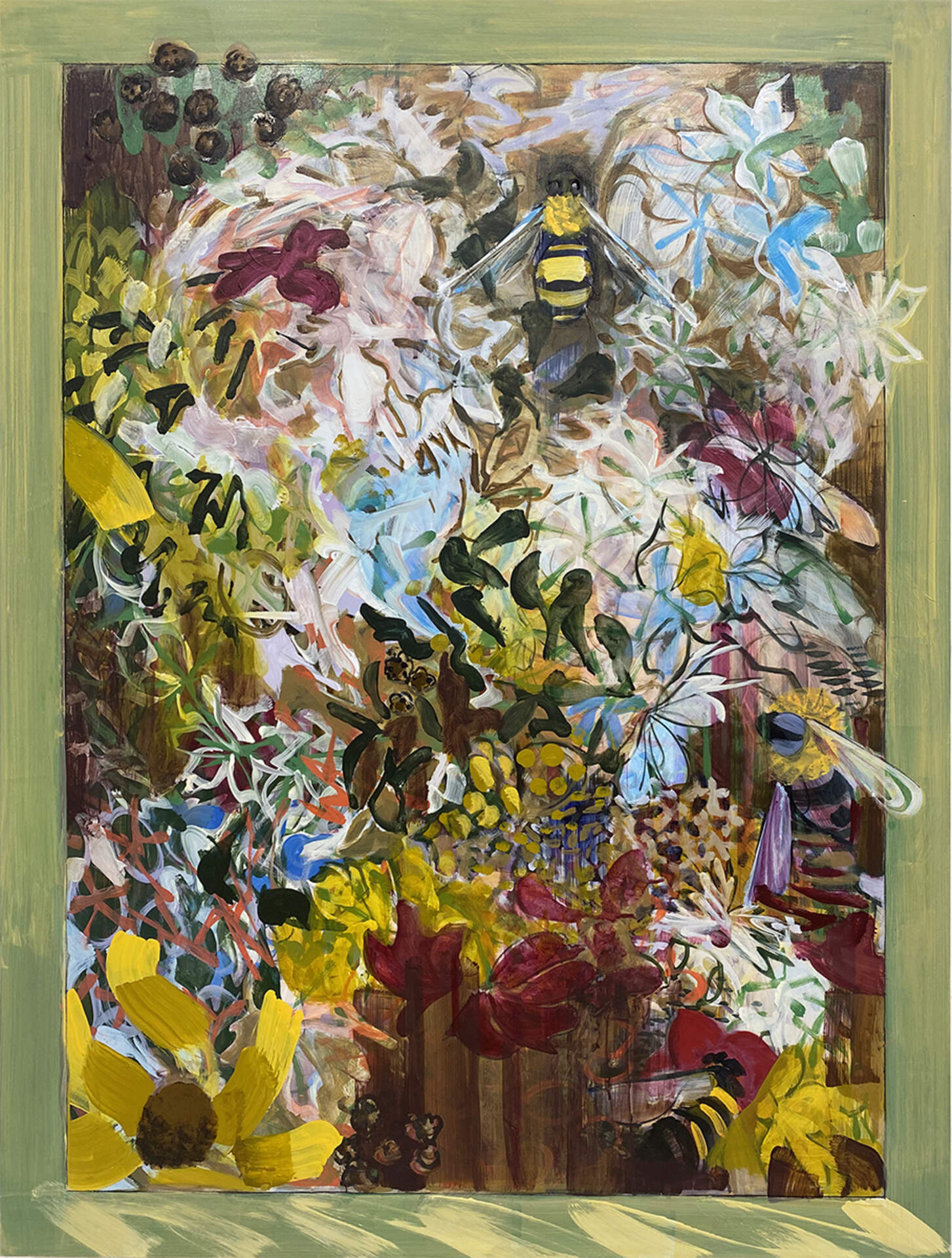Mike Glier (b. 1953)Bees Finding Pleasure v.2
2023
acrylic and charcoal on panel
40 x 30 inches
Courtesy Krakow Witkin Gallery, Boston
FRAGRANCE AND THE UMWELT
NW: For much of his adult life, Charles Burchfield searched for wild sweet peas that he remembered from childhood. To capture this indelible memory, he painted Sweet Pea Mood in 1917—his “Golden Year” of inventive experimentation. Yet, decades afterward, he often remarked that he couldn’t find “anything like my memory of them.” The significance is quite apparent in his early 1950s autobiographical manuscript. Chapter I, “Wild Sweet Peas” which begins with his first years of life in Ashtabula Harbor, Ohio. He reminisced about this “mystical flower—incredibly soft & velvety” that he discovered on a lane leading to a Lake Erie beach: “Here in the soft yielding sand grew the wild sweet peas, which have persisted in my memory, as being rich mauve in color – The vague memory of these flowers may be taken as the symbol of all the elusive memories of earliest childhood.” Could his memory have been skewed?
Gloriously, on a visit to Ohio, he found the variety known as “beach peas” so he expanded and reworked Sweet Pea Mood in 1954-55. Studies show his intention to express how “The pink color is felt everywhere, on [the] barn etc.” Their radiant scent permeates all aspects of the painting, including “How a tree appears when smelling sweet-peas.” His wife Bertha asked him how he knew that trees could smell, and he simply answered, “A good question.” The writhing tree in the upper right corner is absorbing the floral perfume from giant pink and red flowers quite a distance away. The whole scene seems intoxicated.
Mike, you often depict scents in your paintings. How have you conceived this invisible sense?
MG: As I made Bees Finding Pleasure v.2, I tried to imagine myself as a bee, burying my fuzzy face in a cloud of color and scent, greedily licking up flavors. Clearly, I had to paint as lusciously as I could muster to get this across.
NW: I can picture you doing that! Trying to conceive the world from the perspective of insects is a typical Burchfield notion. Spiders, crickets, butterflies, and moths appear exaggerated in scale, so we feel shrunken to their size. Distortions in the view beyond hint at an alternative reality—where the scents, sounds, and weather are primary parameters of being.
MG: To suggest scent, I surrounded the bee with little cloud shapes, since scent is delivered as an aerosol to the nose, but scientifically speaking this was a dumb move, since bees smell with their feet! Can you picture what the world would be if we could smell with our feet? I think I’d like my bedroom flooring to be made from eucalyptus and cinnamon wood. This funny little exercise in bee empathy is a potent way to understand the Umwelt, a proposal that the world is not a stable picture, but that every species experiences the earth a little differently. The blue sky, warm sun, and sloshing ocean that we humans think is so universal is in fact a creation of our human senses and that other living things may know an entirely different earth! This blows my mind.
NW: Ed Yong’s widely praised book, An Immense World: How Animal Senses Reveal the Hidden Realms Around Us taught me so much about the concept of the Umwelt. I’m grateful you told me about it. Yong’s explorations based on the most recent scientific findings are simply amazing, proving that humans are only beginning to comprehend how complex and diverse the world is. It's astonishing that scientists have the means to make these discoveries that dispel antiquated observations and assumptions. Since you read it first, why don’t you explain Umwelt.
MG: Umwelt is the idea that animals all experience the world differently from one another, since they have distinct perceptual abilities. The fuzzy hairs on Bumble Bees, for example, are exquisitely sensitive to air currents. Even the slight electrical charge of a flower is enough to move the hairs and trigger a nervous signal. By measuring the electrical field surrounding the flower, the bee can even tell if the flower has been recently visited, or if it is untouched and full of nectar. For the bee, the sense of touch is so sensitive that it engages another sense, that of electroreception, (a sense shared with electric eels!). The Umwelt of bees differs from that of humans in other ways as well. Bees can also taste with their feet and see into the ultraviolet range to experience colors we can only imagine. We can never fully enter the Umwelt of other animals, since our own Umwelt limits what we can know. Science of course greatly extends our perceptual capacity as does imagination, but still, the world is assessed, interpreted and navigated in endless ways, all different from our own. To realign humanity with the remainder of the living world, it is necessary to decenter human experience, and nothing does so more persuasively than the concept of Umwelt.
